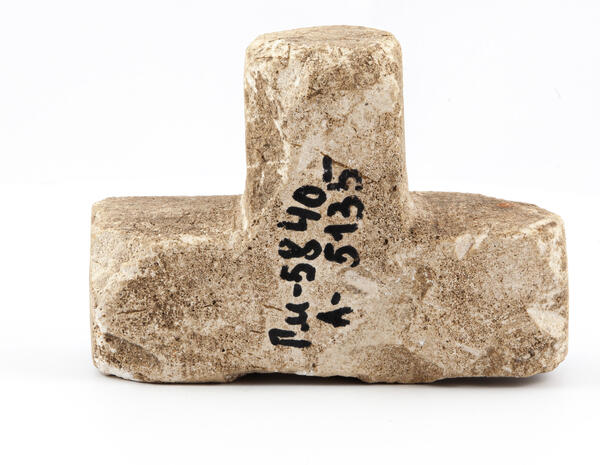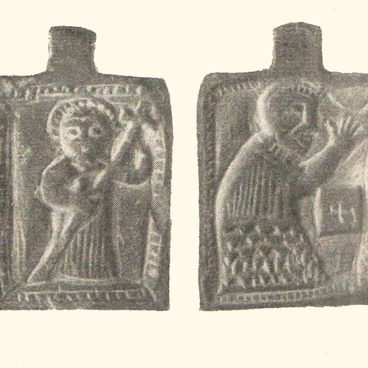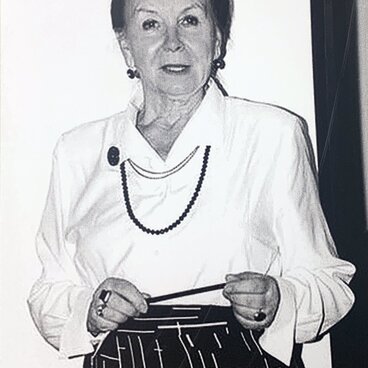The image of a cross has been around since the earliest civilizations. Experienced treasure hunters know that various types of painted crosses can be found in caves and on rocks. During archaeological excavations, experts came across images of crosses, which could be dated back to the Stone Age.
For example, a whole series of ancient cross-shaped sculptures were discovered in Cyprus. One of them, the so-called Idol of Pomos, has been dated to the 30th century BC. This sculpture is notable for a string with a cross around its neck. The image of the idol is reproduced on the €1 and €2 coins as the symbol of Cyprus.
The Orthodox Church of Kievan Rus made the cross their most important religious symbol. Orthodox Russians made the sign of the cross, on their bodies they wore crosses, received at baptism. In the Christian church, the cross designates both the instrument of Jesus’ crucifixion (a wooden cruciform) and the crucified figure of the son of God, symbolizing divine peace and dignity.
A fragment of a big limestone cross with a relief image of a crucifix was discovered in 2017 on the territory of the Holy Trinity-St. Nicholas Monastery in Gorokhovets, Vladimir Oblast. This Orthodox monastery was founded in the second quarter of the 17th century; it is currently part of the Murom eparchy.
The relic was discovered during the preparation of exploratory shafts, that is, small pits, which were intended to determine the location of the passage gate with the gate church of the Intercession of the Most Holy Mother of God. The presented limestone cross was the only object of this type found in this town.
The depiction of Christ on the cross seems rather archaic given that it was created in the 17th–18th centuries; its iconography is more typical of earlier historical periods. An icon made on a piece of slate was also found on the territory of the Holy Trinity-St. Nicholas Monastery. One of its sides depicts a saint with a halo, the other — a kneeling man in profile. The expert who found this object distinguished the schematic nature of the image, its special carving technique, and the inaccurate proportions of the body parts. He suggested that the icon had been made by a local craftsman.
For example, a whole series of ancient cross-shaped sculptures were discovered in Cyprus. One of them, the so-called Idol of Pomos, has been dated to the 30th century BC. This sculpture is notable for a string with a cross around its neck. The image of the idol is reproduced on the €1 and €2 coins as the symbol of Cyprus.
The Orthodox Church of Kievan Rus made the cross their most important religious symbol. Orthodox Russians made the sign of the cross, on their bodies they wore crosses, received at baptism. In the Christian church, the cross designates both the instrument of Jesus’ crucifixion (a wooden cruciform) and the crucified figure of the son of God, symbolizing divine peace and dignity.
A fragment of a big limestone cross with a relief image of a crucifix was discovered in 2017 on the territory of the Holy Trinity-St. Nicholas Monastery in Gorokhovets, Vladimir Oblast. This Orthodox monastery was founded in the second quarter of the 17th century; it is currently part of the Murom eparchy.
The relic was discovered during the preparation of exploratory shafts, that is, small pits, which were intended to determine the location of the passage gate with the gate church of the Intercession of the Most Holy Mother of God. The presented limestone cross was the only object of this type found in this town.
The depiction of Christ on the cross seems rather archaic given that it was created in the 17th–18th centuries; its iconography is more typical of earlier historical periods. An icon made on a piece of slate was also found on the territory of the Holy Trinity-St. Nicholas Monastery. One of its sides depicts a saint with a halo, the other — a kneeling man in profile. The expert who found this object distinguished the schematic nature of the image, its special carving technique, and the inaccurate proportions of the body parts. He suggested that the icon had been made by a local craftsman.




